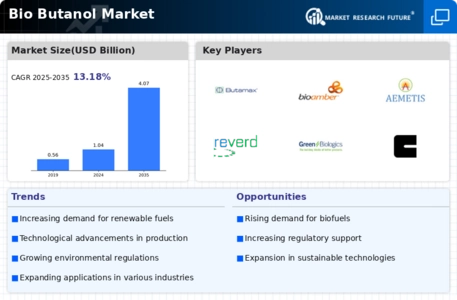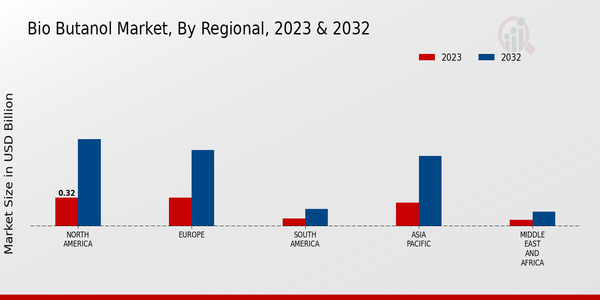Market Growth Projections
The Global Bio Butanol Market Industry is projected to experience substantial growth, with estimates indicating an increase from 1.04 USD Billion in 2024 to 4.07 USD Billion by 2035. This growth trajectory suggests a compound annual growth rate (CAGR) of 13.22% from 2025 to 2035, reflecting the increasing adoption of bio butanol as a sustainable fuel alternative. The market dynamics are influenced by various factors, including technological advancements, supportive government policies, and rising consumer awareness regarding sustainability. As these elements converge, the bio butanol market is poised for significant expansion in the coming years.
Supportive Government Policies
Government policies and incentives are significantly influencing the Global Bio Butanol Market Industry, as many countries are promoting biofuels to achieve energy independence and reduce carbon footprints. Subsidies, tax credits, and mandates for renewable fuel usage are encouraging investments in bio butanol production. For instance, the Renewable Fuel Standard in the United States has established a framework that supports the growth of biofuels, including bio butanol. Such supportive measures are likely to enhance market dynamics, fostering an environment conducive to growth and innovation, which is critical for achieving the anticipated CAGR of 13.22% from 2025 to 2035.
Growing Demand for Renewable Fuels
The Global Bio Butanol Market Industry is experiencing a surge in demand for renewable fuels, driven by increasing environmental concerns and regulatory support for sustainable energy sources. Governments worldwide are implementing policies to reduce greenhouse gas emissions, which is propelling the adoption of biofuels. Bio butanol, being a versatile biofuel, is gaining traction as a cleaner alternative to fossil fuels. In 2024, the market is projected to reach 1.04 USD Billion, reflecting a growing recognition of bio butanol's potential to contribute to energy security and sustainability goals. This trend is expected to continue, with the market anticipated to expand significantly by 2035.
Technological Advancements in Production
Innovations in production technologies are playing a crucial role in the Global Bio Butanol Market Industry, enhancing the efficiency and cost-effectiveness of bio butanol production. Advances such as fermentation processes and genetic engineering of microorganisms are being explored to improve yield and reduce production costs. These technological improvements not only make bio butanol more competitive against conventional fuels but also facilitate its integration into existing fuel infrastructures. As production methods evolve, the market is likely to witness a substantial increase in output, supporting the projected growth from 1.04 USD Billion in 2024 to 4.07 USD Billion by 2035.
Increasing Applications in Various Industries
The versatility of bio butanol is driving its adoption across various industries, thereby propelling the Global Bio Butanol Market Industry. Bio butanol is not only utilized as a fuel but also serves as a solvent, plasticizer, and intermediate in chemical synthesis. Its applications in the automotive, pharmaceuticals, and cosmetics sectors are expanding, as industries seek sustainable alternatives to traditional petroleum-based products. This diversification of applications is expected to contribute to the market's growth trajectory, with projections indicating a rise from 1.04 USD Billion in 2024 to 4.07 USD Billion by 2035, highlighting the increasing recognition of bio butanol's multifaceted benefits.
Rising Consumer Awareness and Preference for Sustainable Products
Consumer awareness regarding environmental issues is on the rise, influencing purchasing decisions and driving the Global Bio Butanol Market Industry. As individuals become more conscious of their carbon footprints, there is a growing preference for sustainable products, including biofuels. This shift in consumer behavior is prompting manufacturers to explore bio butanol as a viable alternative to conventional fuels. The increasing demand for eco-friendly products is likely to stimulate market growth, aligning with the broader trend of sustainability in consumer choices. This evolving landscape may further support the anticipated growth trajectory of the bio butanol market.



















Leave a Comment